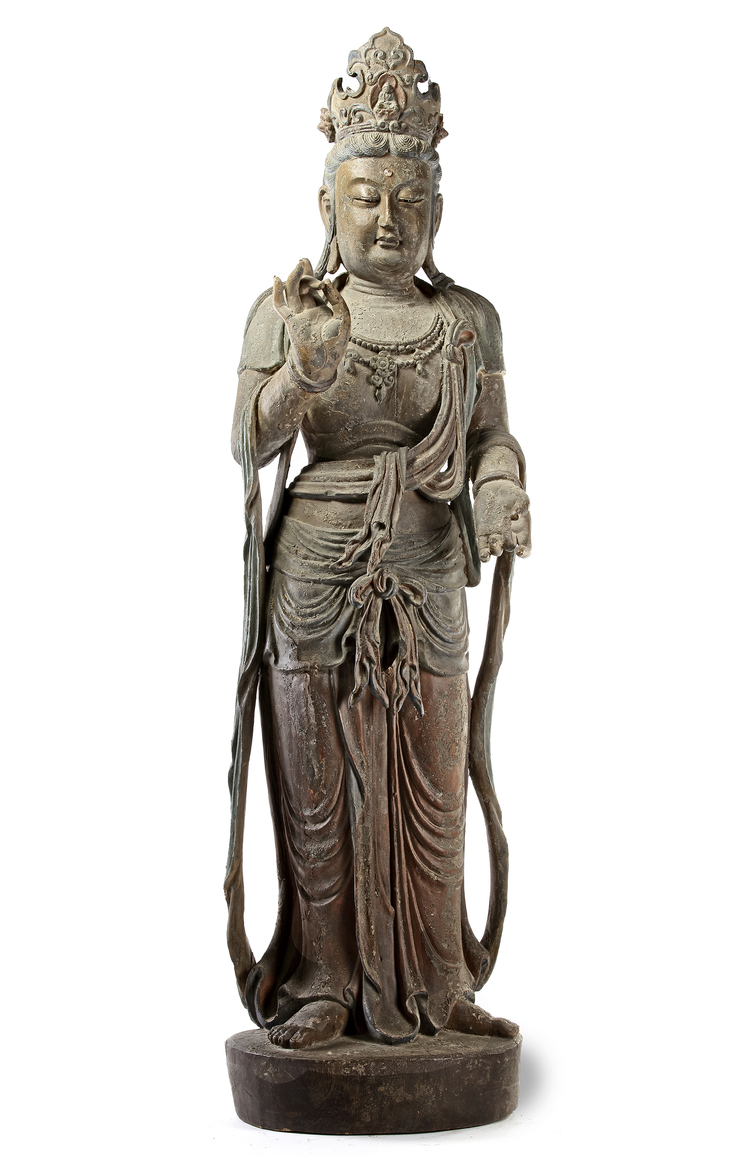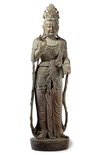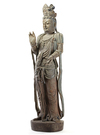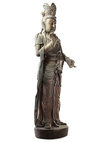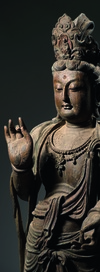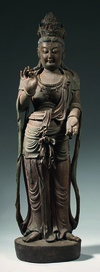A CHINESE STANDING POLYCHROME WOOD FIGURE OF GUANYIN, LATE MING DYNASTY
Representations of Guanyin, the Buddhist god of Compassion and Mercy, went through a series of stylistic changes throughout the different stages of Chinese art. From the thin and elongated version of the Six Dynasties (265-589), it slowly became indianized with clinging drapery and billowing scarves. Later in the Tang period (618-907 AD) the figure gradually became more and more robust, powerful, majestic in posture and resplendent in jewellery. Thisform was more or less accepted as the standard one during the Song dynasty (960-1279 AD). During the subsequent dynasties of the Yuan (1279-1368 AD)and Ming (1368-1644 AD) wooden examples of this sacred image became even more robust and fleshy. Towards the end of the Ming period a more stylized type became en vogue that continued well into the Qing dynasty. Although these Qing examples, like the one under review, are well carved, detailed, the general feeling is one of a more mannered execution. Often these later figures are carved with exuberant tiaras in front of an elaborate chignon. The Buddhist god of Compassion, Guanyin, had become the most popular of all subjects by the Song dynasty. This eminent role he would keep till the late forties of last century when communism became the official dogma in China. Figures in wood were especially plentiful and this popular tradition continued into later dynasties. Often these wood examples were of large size like the one under discussion. The presented one is carved in the round and stands on a circular plinth. The raised right hand demonstrates the wish-granting gesture while the left stretches along his body and displays the same gesture. Around his hips is draped a pleated garment reaching to his feet and secured with a sash knotted at the front. A long scarf is floating around his body of which both ends touch the plinth at the backside. Bandoleer his chest is another scarf visible. Furthermore his body is decorated with bracelets, armlets and necklace. The facial expression is not only serene but also of a stern and aloof countenance giving the bodhisattva an authoritative appearance. The eyes are carved downcast below arched eyebrows, a bead inlaid third eye, aquiline nose, pronounced lips and elongated earlobes. The latter stand for the spiritual wisdom of the god. His coiffure is combed in a chignon consisting of swags with ribbing and decorated with a triangular shaped ornament at the front. The tiara is carved with scrolling foliate around a minute figure of Amitabha or his spiritual father who is seated on a lotus. A trifurcated strand of hair is falling on each shoulder. Remains of pigments are still visible. Although the presented sacred image of Guanyin is created at the far end of this specific wood carving tradition, he still displays a robust and strong presence with a stern facial expression. Height 135 cm.
PROVENANCE Private collection, The Netherlands
